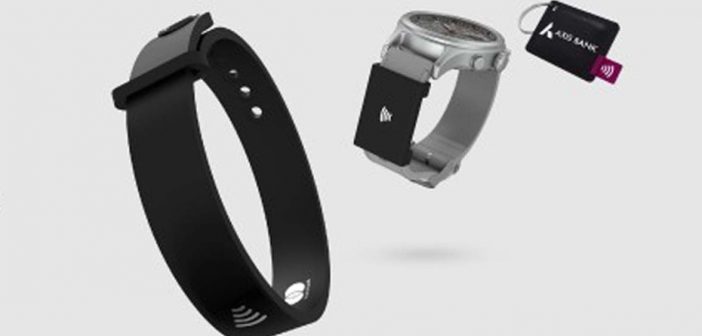The landscape of digital payments in India is evolving with the advent of wearable payment devices, spearheaded by some of the country’s leading banks. These devices, ranging from smartwatches to keychains and wristbands, enable quick and seamless contactless payments. As India progresses towards a cashless economy, these innovative devices are set to reshape how consumers make payments, offering a blend of convenience, security, and style.
What are Wearable Payment Devices?
Wearable payment devices use Near Field Communication (NFC) technology, allowing users to tap their device at a contactless Point of Sale (POS) terminal to complete transactions. Acting as an extension of a debit or credit card, these devices provide an easy alternative to carrying cash or physical cards.
Leading Banks Offering Wearable Payment Devices
Several Indian banks have entered the wearable payments space, providing various types of devices to suit different consumer preferences:
- Axis Bank: Axis Bank’s “Wear ‘N Pay” is one of the most comprehensive offerings, with devices such as wristbands, keychains, and loops. These are linked to a prepaid account, which can be reloaded as needed.
Cost to Consumers: The devices are priced starting from ₹500-₹750. - State Bank of India (SBI): SBI offers NFC-enabled wearables under the YONO brand, such as wristbands and key fobs, facilitating contactless payments directly linked to a customer’s bank account.
Cost to Consumers: The pricing for SBI wearable devices typically ranges between ₹350-₹500. - ICICI Bank: ICICI Bank launched the “ICICI Bank SmartKey,” providing wristbands and other small accessories for contactless payments.
Cost to Consumers: ICICI’s wearable payment devices are priced between ₹500-₹800. - HDFC Bank: The “Wear N Pay” devices by HDFC Bank include keychains and wristbands that link to existing bank accounts.
Cost to Consumers: The devices are offered at a price range of ₹400-₹700, depending on the style. - Yes Bank: Yes Bank has entered into partnerships with various FinTech players to introduce smart payment wearables, including watches and bands.
Cost to Consumers: The price of these wearables typically ranges between ₹500-₹900. - IndusInd Bank: IndusInd Bank introduced its “IndusInd Nexxt” platform, allowing payments through a range of NFC-enabled wearables, including wristbands and tags. The devices are part of the bank’s broader contactless payment strategy.
Cost to Consumers: IndusInd’s wearables are available at ₹600-₹800, depending on the device type.
Types of Wearable Payment Devices
- Wristbands: Offered by banks like Axis, SBI, ICICI, and IndusInd, wristbands are the most common form of wearable devices. They are comfortable, lightweight, and can be worn daily, making payments easy with a simple tap at any contactless terminal.
- Keychains/Key Fobs: Axis Bank and HDFC Bank have launched keychains and fobs, which can be easily attached to keys, bags, or wallets for quick access. Their compact size and portability make them a popular choice for on-the-go payments.
- Smartwatches: Certain banks, in collaboration with global payment networks like Visa and Mastercard, offer smartwatch integration, allowing users to make payments through wearables equipped with fitness and health features.
- Loops and Tags: Axis Bank’s “Wear ‘N Pay” includes payment loops that can be attached to existing accessories, such as watches or bags. These devices provide added flexibility for users looking for unobtrusive, fashion-friendly payment options.
Advantages of Wearable Payment Devices
- Ease of Use: Wearable payment devices offer extreme convenience. Payments are completed with a simple tap, eliminating the need to carry wallets or even smartphones. This is particularly useful for quick purchases at retail stores, public transport, or cafés.
- Increased Security: With encryption and tokenization technology, wearable devices offer high levels of security. Transactions above ₹5,000 typically require an additional authentication method such as a PIN, which reduces the risk of fraud.
- Hygiene and Touchless Payments: Post-pandemic, contactless payments are favored for their hygiene benefits. Wearable devices enable a touch-free payment experience, reducing physical contact with payment terminals.
- Budget-Friendly Prepaid Options: Some banks like Axis and SBI offer prepaid wearable devices, allowing users to top up and control spending. This is ideal for those looking to budget their daily or monthly expenses.
- Widely Accepted: Most wearable devices are compatible with NFC-enabled POS terminals, which are now widespread across India’s urban centers. Consumers can make payments at supermarkets, petrol stations, restaurants, and even in public transportation.
- Stylish and Durable: The wearable devices are designed for everyday wear and can endure daily activities, including water resistance in some cases. With various colors and designs, they also serve as trendy accessories.
Costs to Consumers
While wearable payment devices are relatively affordable, there are some upfront costs associated with acquiring these gadgets. Depending on the bank and the type of device, the pricing typically ranges between ₹350 to ₹900. Prepaid versions may also require a small top-up fee for account activation. Some banks might also charge a nominal fee for replacements if the device is lost or damaged.
Why Consumers Should Use Wearable Payment Devices
- Speed and Convenience: With wearable payment devices, consumers can complete transactions in seconds. This is especially useful for busy individuals who do not want the hassle of searching for cards or cash.
- Security: Wearable devices are secured with multiple layers of encryption, and tokenized payment technology ensures that the device never shares the actual card details with merchants. This provides a significant advantage over traditional payment methods.
- No Battery Worries: Most of the wearable devices don’t require batteries, making them ideal for long-term usage without needing to worry about recharging or battery replacements.
- Hygienic and Safe: In a world where hygiene is a priority, contactless payments are safer, reducing the need for physical contact or the exchange of cash.
- Incentives and Offers: Many banks are offering promotional discounts, rewards, and cashback offers to encourage the use of wearable devices. These perks make the devices more attractive to everyday users.
Market Adoption and Growth
The market for wearable payment devices in India is expected to grow as banks continue to innovate and promote cashless, secure transactions. Data suggests that contactless payment methods, including wearables, are gaining traction, particularly in urban areas where digital adoption is highest. With over 5 million NFC-enabled POS terminals now available across the country, the infrastructure to support this technology is robust and expanding.
Conclusion: Wearable Payment Devices – A Smart Choice for the Future
Wearable payment devices are not just a passing trend; they represent the future of digital transactions. As more Indian consumers embrace cashless payments, these devices offer a simple, secure, and stylish way to pay. Whether it’s for daily purchases or managing budgets, wearable payment devices from banks






